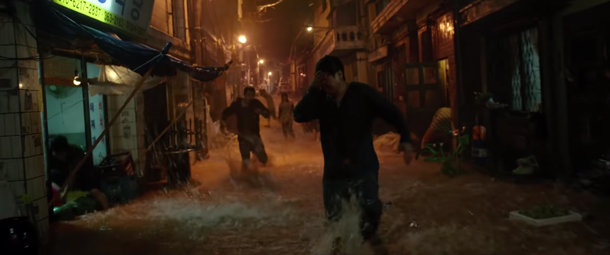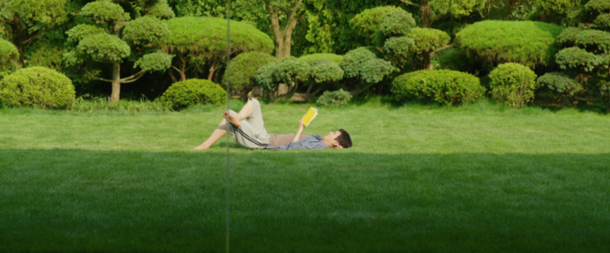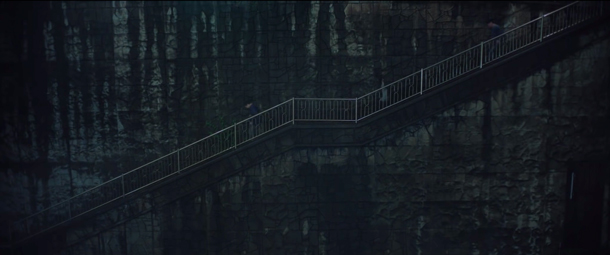‘Parasite’ As Climate Fiction
Air Date: Week of February 28, 2020

In ‘Parasite’, a torrential downpour upends the Kims’ lives when it floods their basement apartment with sewage, while it merely rains out the Parks’ cushy camping trip. (Photo: ‘Parasite’ film still)
‘Parasite’, director Bong Joon-ho’s Oscar-winning film, examines the disproportionate impacts that climate change has on the rich and the poor. Ben Goldfarb a science writer with “The Last Word on Nothing”, explores how climate disruption plays in the plot of ‘Parasite’, and discusses how climate change and inequality manifest in the real world.
Transcript
CURWOOD: The film “Parasite” made Oscar history when it became the first non-English language film to win Best Picture, in addition to rolling up Oscars for Best Director, Best Original Screenplay, and Best International Feature. For writer Ben Goldfarb of the blog “The Last Word On Nothing,” Parasite is also outstanding climate fiction.
GOLDFARB: Parasite, director Bong Joon Ho’s latest masterpiece, is a film about many things: class warfare, the indignities of capitalism, the eternal search for a WiFi signal. Less obviously, it’s also a work of climate fiction that illustrates the very real ways global warming worsens inequality.
Parasite revolves around two Korean families, the wealthy Parks, and the poor Kims. They’re divided not only by social status but by topography. The Parks live behind locked gates in a spotless, well-lit house, up a steep street in the Seoul highlands — a city on a hill. The Kims, who resourcefully infiltrate the Parks’ lives over the course of the movie, squat in a subterranean bunker in a low-elevation slum.
Bong emphasizes this altitudinal gradient. The Kims are forever hustling up and down the steep staircase that leads to their downtrodden neighborhood. While the Parks’ hilltop home feels clean and bright, the Kims’ area gives off a polluted vibe, shot in sickly greens and yellows.

Natural light and green space are accessible only by the wealthy in ‘Parasite’. The Park living room looks out on a lush garden hidden behind a high wall around their property. (Photo: ‘Parasite’ film still)
This difference isn’t just a symbol, it also drives the plot. Near the end of Parasite, a rainstorm causes a flash flood that submerges the Kims’ apartment, backs up sewage and forces them to abandon their few possessions — a humiliation that triggers the film’s chaotic final act.
This is a savvy understanding of how social class and urban geography collude to influence climate risk. Disaster after disaster, we’ve seen that lower-income neighborhoods at lower elevations are more susceptible to extreme weather, Hurricane Katrina and the Philippines’ Typhoon Haiyan being two obvious examples. One recent study showed that poorer people in Myanmar’s Bago City live in more fragile, flood-prone houses, trapping residents in a cycle of poverty.
An equally ominous study set in Miami-Dade County investigated a phenomenon called climate gentrification. The authors found that property values grow faster at higher elevations, away from the rising ocean, and that flooding has suppressed the value of low-elevation homes. Ultimately, researchers conclude, society’s growing preference for lofty heights “may lead to more widespread relocations that serve to gentrify higher elevation communities.”

Bong uses vertical movement and architecture to emphasize the socio-economic distance between the wealthy Park family and the poor Kim family. (Photo: ‘Parasite’ film still)
Bong Joon Ho has examined climate change and inequality before: In his dystopian thriller Snowpiercer, a failed geoengineering experiment turns the planet into an iceball, forcing the survivors onto a train with a brutal caste system. Parasite’s invocation of climate change is more subtle. Although the film never explicitly mentions global warming, it’s the inescapable backdrop, at once unobtrusive and ever-present, just as it is in real life. The Parks are oblivious to their climate privilege even as it shapes their world. The morning after the deluge that destroys the Kims’ home, the matriarch of the Park family chats on the phone with a friend from the backseat of her chauffeured car. “Did you see the sky today?” she says. “Crystal clear. Zero air pollution. Rain washed it all away.”
CURWOOD: Ben Goldfarb writes for the science blog, The Last Word On Nothing.
Links
The Last Word on Nothing | “Parasite Is Great Cli-Fi”
Watch: “The Ending of ‘Parasite’ Explained | Pop Culture Decoded”
Living on Earth wants to hear from you!
Living on Earth
62 Calef Highway, Suite 212
Lee, NH 03861
Telephone: 617-287-4121
E-mail: comments@loe.org
Newsletter [Click here]
Donate to Living on Earth!
Living on Earth is an independent media program and relies entirely on contributions from listeners and institutions supporting public service. Please donate now to preserve an independent environmental voice.
NewsletterLiving on Earth offers a weekly delivery of the show's rundown to your mailbox. Sign up for our newsletter today!
 Sailors For The Sea: Be the change you want to sea.
Sailors For The Sea: Be the change you want to sea.
 The Grantham Foundation for the Protection of the Environment: Committed to protecting and improving the health of the global environment.
The Grantham Foundation for the Protection of the Environment: Committed to protecting and improving the health of the global environment.
 Contribute to Living on Earth and receive, as our gift to you, an archival print of one of Mark Seth Lender's extraordinary wildlife photographs. Follow the link to see Mark's current collection of photographs.
Contribute to Living on Earth and receive, as our gift to you, an archival print of one of Mark Seth Lender's extraordinary wildlife photographs. Follow the link to see Mark's current collection of photographs.
 Buy a signed copy of Mark Seth Lender's book Smeagull the Seagull & support Living on Earth
Buy a signed copy of Mark Seth Lender's book Smeagull the Seagull & support Living on Earth

